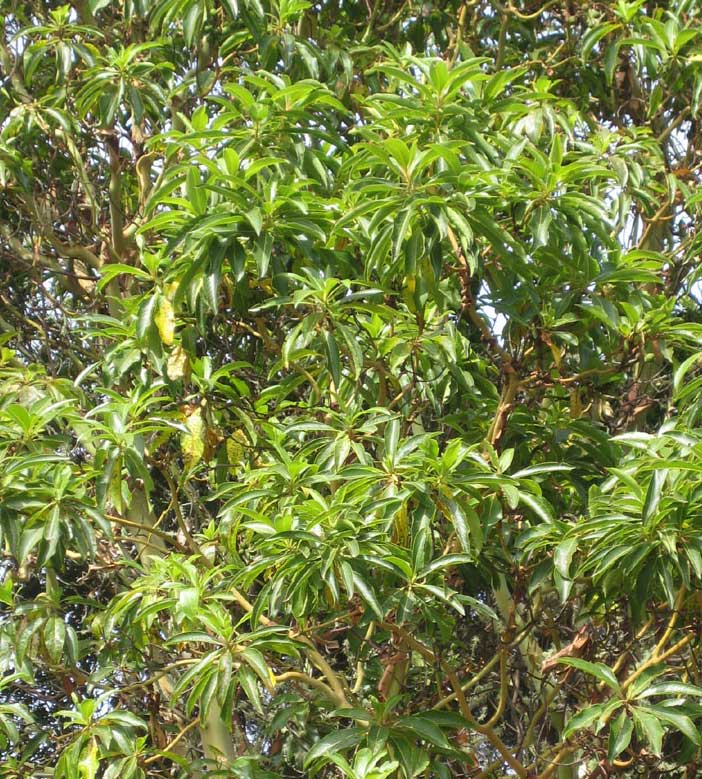
Arbutus canariensis (*)
Classification System: APG IV
Superregnum: Eukaryota
Regnum: Plantae
Cladus: Angiosperms
Cladus: Eudicots
Cladus: Core eudicots
Cladus: Asterids
Ordo: Ericales
Familia: Ericaceae
Subfamilia: Arbutoideae
Genus: Arbutus
Species: Arbutus canariensis
Name
Arbutus canariensis Veill. in Duhamel, Traité Arbr. Arbust., nouv. ed., 1: 80. 1803.
Synonyms
Homotypic
Arbutus canadensis Poir. ex Steud., Nomencl. Bot.: 62. 1821, sphalm.
Heterotypic
Arbutus callicarpa Buch, Phys. Beschr. Canar. Ins. 146. 1828.
Arbutus longifolia Andrews, Bot. Repos. 10: t. 664. 1814.
Arbutus procera Sol. ex DC., Prodr. 7: 581 1839, nom. illeg. non Lindl. (1835).
Distribution
Native distribution areas:
Continental: Africa
Regional: Macaronesia
Canary Islands (Gomera, Gran Canaria, Hierro, La Palma, Tenerife).
References: Brummitt, R.K. 2001. TDWG – World Geographical Scheme for Recording Plant Distributions, 2nd Edition
References
Govaerts, R. et al. 2019. Arbutus canariensis in Kew Science Plants of the World online. The Board of Trustees of the Royal Botanic Gardens, Kew. Published online. Accessed: 2019 Sep 18. Reference page.
Euro+Med 2006 onwards: Arbutus canariensis in Euro+Med PlantBase – the information resource for Euro-Mediterranean plant diversity. Published online. Accessed: 2019 Sep 18.
USDA, ARS, Germplasm Resources Information Network. Arbutus canariensis in the Germplasm Resources Information Network (GRIN), U.S. Department of Agriculture Agricultural Research Service.
Vernacular names
català: Arboç de Canàries
Deutsch: Kanarischer Erdbeerbaum
English: Canary Islands Strawberry-tree
Esperanto: Kanaria arbuto
español: Madroño canario
Arbutus canariensis, known in Spanish as madroño canario, is a species of shrub or tree in the heath family. It is endemic to the Canary Islands of Spain, specifically Tenerife, La Gomera, Gran Canaria, El Hierro, and La Palma. It is threatened by habitat loss.[1]
Hybrids
Arbutus x thuretiana Demoly is a hybrid between A. canariensis and A. andrachne.[3] Named after Gustave Thuret, it is naturalised at Jardin botanique de la Villa Thuret.[4] A. x thuretiana is renowned for its perfectly smooth, reddish-brown bark, exfoliating in the spring to show a new, surprisingly pistachio-green bark, which gradually darkens and turns reddish again.[3]
References
Beech, E. (2017). "Arbutus canariensis". IUCN Red List of Threatened Species. 2017: e.T30322A81768520. doi:10.2305/IUCN.UK.2017-3.RLTS.T30322A81768520.en. Retrieved 16 November 2021.
The Plant List, Arbutus canariensis Duhamel
Filippi, Olivier (2007). Pour un jardin sans arrosage (For a garden without irrigation) (in French). Arles: Actes Sud. p. 80. ISBN 978-2-7427-6730-4.
Ducatillon, Catherine; Bellanger, Richard; Charron, Tristan; Chevallier, Joelle; Heinz, Christine; Marchal, Cecilia; Mellerin, Yannick; Caraglio, Yves; Ameglio, Thierry (2018), "Study of the adaptability of trees to drought:phenological monitoring of assisted growth sensors, in the Botanical Garden of Villa Thuret", Proceedings of the EuroGard VII Congress, EUROGARD, vol. VII, pp. 322–331, retrieved 2020-03-23
Retrieved from "http://en.wikipedia.org/"
All text is available under the terms of the GNU Free Documentation License

